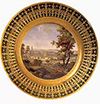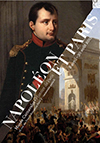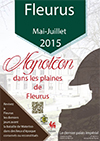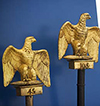| |
| |
EDITORIAL > PARIS ÉTERNEL
“Eternal Paris”, a phrase that's been on lips of Parisians since the day it was coined. Our interview with Thierry Sarmant shows that it wouldn't have been out of place in Napoleon's mouth. For him, Paris was to be the jewel in his European imperial crown. Paved, clean streets, rationally numbered and distributed, punctuated with monuments to the glory of France, French military prowess, and the Emperor himself. Just as the Revolution had cleared away the dead wood of the old world, so Napoleon wanted modern Paris to shine as a model of modernity and French national pride. Though his fall, and the even worse catastrophe at Sedan, were to render it impossible for there ever to be a ‘Rue Napoléon le Grand”, nevertheless the modern city flashes like silk shot through with the names and places (indeed even voids) that exude Napoleon, his tumultuous epoch and the grandeur of the Empire!
Enjoy your read on napoleon.org.
Peter Hicks
Historian and Head of International Relations, Fondation Napoléon

|
|
|
| |
OBJECT OF THE MONTH > DESSERT PLATE FROM THE «SERVICE PARTICULIER DE L'EMPEREUR» : "LE PRYTANÉE DE SAINT-CYR"
In 1807, Napoleon comissioned the Sevres manufactory to make a table service for his own personal use, usually known as the "Service particulier de l'Empereur". This famous service, better known as the "Headquarters" service, is remarkable not only for its quality and beauty but also for the role which Napoleon played in the conception of its designs and the choice of subjects. This plate which illustrates the scene, "Prytannée de Saint-Cyr", is currently part of the exhibition "Napoléon, Wellington: destins croisés", at the Musée Wellington in Waterloo until 31 July, and is one of the Masterpieces of the Fondation Napoléon's collection.

|
|
|
| |
INTERVIEW > THIERRY SARMANT AND "NAPOLEON ET PARIS" AT THE MUSEE CARNAVALET
Aside form being a great military personality, Napoleon was also a great urban reformer, and the capital city of France was the first to benefit from his vision. The current exhibition at the Musée Carnavalet, “Napoléon et Paris” is one of the highlights of this year's exhibitions in Paris as well as of all the exhibitions focussing on the bicentenary year of 1815 in Europe. You've still got until 30 August 2015 to see it! To whet your appetite napoleon.org asked Thierry Sarmant, co-curator, to tell us more about the exhibition.
TELEVISION > NAPOLEON ET PARIS, A LA RECHERCHE DU REVE IMPERIAL
The Fondation Napoléon and the Musée Carnavalet have collaborated with France Televisions to produce a documentary which explores Napoleon's project to make Paris into the most beautiful city in the world. It will be broadcast on 7 June on France 5, then 26 June sur France 3 Île-de-France. Read more here (external link in French).

|
|
|
| |
EXHIBITION > “WATERLOO 1815: THE ART OF BATTLE”
Yesterday a new exhibition confronting works of art, armour and arms called "The Art of Battle" has opened at the Royal Armouries Museum in Leeds (UK) to commemorate the 200th anniversary of the battle of Waterloo (until 23 August 2015).
Among the star exhibits is a monumental full-scale drawing (or “cartoon”) on paper for a painting by Daniel Maclise (1806-1870) depicted the meeting of Wellington and Blücher after the battle of Waterloo in front of the "Belle Alliance" Inn. The entire work comprises ten panels, recently restored and on loan from the Royal Academy of London, and measures 3 metres high by 13 metres long. Also on show is a model of the battle of Waterloo completed in 1843 by Captain William Siborne. The exhibit also includes several weapons used at the battle of Waerloo.
As part of the event there will also be a Study Day on 13th June.
There is a furthur exhibition of weaponry Waterloo Lives: Wellington's Redcoats opening at Bankfield Museum Halifax, UK. Read more about it in this article (external link). And arms expert, Paul Wilcock, from the university of Huddersfield (UK) provides insights into weaponry used at the Battle of Waterloo, as described in this recent article (external link).

|
|
|
| |
AN EXHIBITION AND SOME RE-ENACTMENTS > "NAPOLEON IN THE FIELDS OF FLEURUS", BELGIUM
From 22 May to 2 August the Château de la Paix, (Fleurus, Belgium) will be commemorating Napoleon's final victory there with an exhibition “Napoléon dans les pleines de Fleurus”. The Fondation Napoléon is lending for this event a monogrammed ring and glass, both belonging to the Emperor, a medal of the Légion d'honneur, a statuette of Ney on the evening of Waterloo, a one-franc coin, and a watch given by Napoleon to Vantini on the island of Elba.
On this occasion the bedroom that the Emperor occupied at the Chateau will be reconstructed (external link in French).
Several events and re-enactments in commemoration of the battle of Ligny, Napoleon's last victory, will also take place from 12 to 16 June, in the region. See here for more details (external link in French).

|
|
|
| |
“WATERLOO, AFTER THE BATTLE”, NATIONAL MUSEUM OF SCOTLAND, 15 MAY - 27 SEPTEMBER
The only two French Napoleonic eagles captured at Waterloo are now on display together for first time in almost sixty years (external link) in an exhibition at the National Museum of Scotland, "Waterloo after the battle". The eagle of the French 45th Infantry, taken by Sergeant Ewart of the Scot Greys, on loan from the Royal Scots Dragoon Guards Museum in Edinburgh Castle, will be on show throughout the exhibition run, while the eagle of the French 105th Infantry – which is on loan from The National Army Museum London – will be displayed only until 31 May.
TALK > On 9 September by Paul O'Keeffe, author of Waterloo: The Aftermath and a new edition of Walter Scott's writings on Waterloo, investigates the looting of the battlefield, the clearing of its dead and wounded, and its invasion by sensation- and souvenir-seeking tourists. See here for more details (external link).
26 MAY IN NAPOLEONIC HISTORY
> Napoleon crowned king of Italy, 26 May 1805 in Milan.
> Abd el-Kader, of the Algerian Restistance under the Second Empire, dies in Damas le 26 May 1883: Close up on Abd El-kader.
200 YEARS AGO > CONSULTATIONS FOR CONFEDERATE GERMANY.
After the lengthy discussions at the beginning of 1815 addressing the issues of Poland and Saxony (see info Letter No. 745), the Congress of Vienna was then able to move on to the question of what do to with the rest of Germany, including Napoleon's Confederation of the Rhine (see our Focus on the confederation here). The Committee for the Affairs in Germany, led by Austria, Prussia, Great Britain and Russia, had presented an initial draft of a project for the reorganization of the German-speaking territories in February 1815 but this had met with stiff opposition from the smaller states concerned, who felt they had been left out of the negotiations. Once the specific claims of these small states had been studied, Austria presented a draft constitution for a German Confederation or Deutscher Bund in early May 1815. The project was studied by a conference, which was opened to all potential members of the future confederation on 25 and 26 May. The one point they could all agree on was that none of them desired the return of the French Emperor; indeed they were keen to establish perfect equality between member states without the over-riding power of a higher degree, thereby ensuring the absence of an Emperor at the head of this Confederation despite the presidency of the diet being held by the Emperor of Austria. The constitutional articles of this German Confederation were to be drafted relatively quickly. Begun on 1 June, the constitution was approved by the two major allies directly involved, Austria and Prussia, on 5 June and formally signed on 8 June (in reality the 10 June) by all of its 38 members. (full text in German, external link)
150 YEARS AGO > THE EMPEROR AND THE PRINCE NAPOLEON FALL OUT, AGAIN!
During the whole month of May 1865 while Napoleon III was touring Algeria (see Bulletin no. 756), he left the Regency in the hands of Empress Eugenie, who was to preside over the Council of Ministers and the Privy Council of which the Prince Napoléon (PlonPlon), the Emperor's 'difficult' cousin, held the position of vice-president. PlonPlon was to attend the unveiling of a monument to the memory of Napoleon I and the latter's four brothers in Ajaccio. On this occasion 15 May he made an “eloquent” speech, but used the opportunity to put forward a plea for extreme liberty and also attacked the Temporal Power of the Pope which had the diplomatic support of the government. So subversive, it was felt, were his words that the Empress forbad the Moniteur from publishing this speech; not that this stopped the Prince Napoleon, who promptly sold his words to a publisher who printed 400,000 copies. The Emperor, returning to Alger on 23 May, where he received a transcript of what PlonPlon had said in Ajaccio, presumably ‘choked on his coffee' and immediately bashed off a letter to his cousin “…putting on record the painful impression the reading of your speech delivered at Ajaccio has given me … The political programme which you place under the aegis of the Emperor can only serve the enemies of my government”. And to underline his opprobrium, a copy of the Emperor's letter was also delivered to Eugenie with instructions for it to be printed in the Moniteur. This letter was published on 27 May. As a result of this ill-judged outburst, the Prince Napoleon was to resign from his position in the Privy Council and also from the presidency of the Imperial Commission of the Exposition Universelle of 1867. And for the next twelve months, the Prince Napoleon kept a low profile at least on the political scene. The ‘unpleasantness' however was soon to be put behind them when the Emperor wrote to the Prince Napoleon on 21 June 1865 expressing his wish “to put an end to [their] divergence in the eyes of the world”. Indeed in July 1866, the Emperor entrusted the Prince with the mission of going to Italy in order to make the King there sign an armistice with Austria, hopefully persuading the world that the two cousins were once again ‘singing from the same song sheet'.
Wishing you an excellent Napoleonic week!
Peter Hicks and Rebecca Young
THE NAPOLEON.ORG BULLETIN No. 760, 22 - 28 MAY, 2015
Interested in the work of the Fondation Napoléon? Why not participate, either generally or in a specific project, by making a donation?
© This Napoleon.org weekly bulletin is published by the Fondation Napoléon. Reproduction or all or part of this bulletin is forbidden, without prior agreement of the Fondation Napoléon.

|
|
|
|
|
|
|
|
WATERLOO BICENTENARY 1815-2015
What's on this year relating to the Bicentenary of the Battle of Waterloo: commemorations, books, exhibitions, news ...
WATERLOO > WHAT'S ON (updated 22/5/15)
WATERLOO > SEEN ON THE WEB (updated 22/5/15)
WATERLOO > READING LIST (updated 22/5/15)
Follow us on Facebook and on Twitter!
napoleon.org - related content:
PRESS REVIEW
- Several selections of Waterloo books
- Review of Bernard Cornwell's 'Waterloo' in the Barnstable Patriot
WHAT'S ON (see our website for all events)
Talks
- "Waterloo 1815: The Image and the Battle", Brown University, Providence, USA [23/05/2015]
- Waterloo and Wellington: Lecture Series, Apsley house, London [05/05/2015 - 21/06/2015]
- "Battle of Waterloo: A Defining Moment", by Paul Chamberlain, Peterborough, UK [29/05/2015]
- "The Hundred Days: Napoleon's Road from Elba to Waterloo", by Mark Adkin, Army & Navy Club, London [11/06/2015]
- "Napoleon the Great", by Andrew Roberts, British Museum [19/06/2015]
- Battle of Waterloo Commemorative Walks in London, UK [21/03/2015 - 20/06/2015]
Conferences
- International congress “From Battlefield to Drawing Room: textile and (military) fashion around 1815” Brussels, Belgium [10/06/2015 - 12/06/2015]
- 'Waterloo Revisited' Bomann-Museum, Celle, Germany [12-13/06/2015]
- 'Popular Reactions and State Responses to the 100 Days' University of Warwick, UK [07/07/2015]
- 'Die Schlacht von Waterloo 1815 und die deutschen Truppen' Bomann-Museum, Celle, Germany [19/09/2015]
Exhibitions
- 'Waterloo 1815: The Art of Battle' Royal Armouries Museum Leeds, UK [22/05/2015 - 23/08/2015]
- 'Napoléon dans les plaines de Fleurus' Château de la Paix, Fleurus, Belgium [22/05/2015 - 02/08/2015]
- '"A damned serious business": Waterloo 1815, the battle and its books' Cambridge University Library, UK, and online [01/05/2015 - 16/09/2015]
- 'Wellington and Waterloo: "the tale is in every Englishman's mouth"' University of Southampton Library, UK [13 April -19 June and 13-24 July 2015]
- 'The Road to Waterloo' and ‘Waterloo Lives' Gordon Highlanders Museum, Aberdeen, Scotland [03/02/2015 - 28/11/2015]
- 'Waterloo' at the Bomann-Museum, Celle, Germany [02/04/2015 - 11/10/2015]
- 'Napoleon und Bayern' Bayerisches Armeemuseum, Ingolstadt, Germany [30/04/2015 - 30/10/2015]
- 'Napoléon Ier ou la légende des Arts, 1800 –1815' Compiègne, France [24/04/2015 - 27/04/2015]
- 'Waterloo 1815 - The Battle for Peace' at Wellington Arch and new display at Apsley House London UK [18/04/2015 - 30/12/2015]
- 'Cap sur l'Amérique - La dernière utopie de Napoléon' Chateau de Malmaison, France [22/04/2015 - 20/07/2015]
- 'Napoléon et Paris, rêves d'une capitale' Musée Carnavalet, Paris [08/04/2015 - 30/08/2015]
- 'Le congrès de Vienne, l'invention d'une Europe nouvelle' Musée Carnavalet, Paris, France [08/04/2015 - 30/07/2015]
- 'Napoléon-Wellington: Destins Croisés' Wellington Museum, Waterloo, Belgium [21/03/2015 - 31/07/2015]
- Waterloo 1815-2015: Visions of war' Bibliothèque Paul Marmotton, Paris, FR [15/04/2015 - 11/07/2015]
- 'Pie VII face à Napoléon: la Tiare dans les serres de l'Aigle' Fontainebleau, FR [28/03/2015 - 29/06/2015]
- 'Alexander, Napoleon and Josephine: a story of war, art and friendship' Hermitage, Amsterdam, NL [28/03/2015 - 08/11/2015]
- 'Modern Heroism: Printmaking and the legacy of Napoleon Bonaparte' Fitzwilliam Museum, Cambridge UK [03/02/2015 - 28/06/2015]
Commemorations
- La Route du Prince Impérial, Louis Napoléon, French week and concert, South Africa [24/05/2015 - 30/05/2015]
- Major Percy victory route (recreated by bike): The Ride of the Lions, Waterloo 200 [17/06/2015 - 20/06/2015]
WATERLOO > WHAT'S ON (updated 22/5/15)
SEEN ON THE WEB (all external links)
- Royal Mint Releases Precious Metal Editions of Battle of Waterloo 2015 UK £5 Coin
- The redcoats of George III will take over Tilbury Fort this weekend to 'practice' for the famous Battle of Waterloo (23-24 May)
- Why we'd be better off if Napoleon never lost at Waterloo (Andrew Roberts)
- The Isle of Man Post Office together with Waterloo 200 issues four se-tenant pairs of stamps to commemorate the Bicentenary Anniversary of the Battle of Waterloo.
"WATERLOO" > SEEN ON THE WEB (link to our website, updated 22/5/15)
THE BIBLIOTHÈQUE MARTIAL-LAPEYRE FONDATION NAPOLEON LIBRARY
The library is normally open on Mondays and Tuesdays from 1pm to 6pm and on Thursdays and Fridays from 10am to 3pm. The library is closed on Wednesdays.
Online database catalogue
Digital Library
Contact
NAPOLEONICA LES ARCHIVES
Site of digitised Napoleonic archival material:
The working papers or 'imprimés' of the Napoleonic Conseil d'Etat, the correspondence of Vivant Denon, etc.
http://www.napoleonica.org
Contact: napoleonica@napoleon.org
NAPOLEONICA. LA REVUE
International peer-review interdisciplinary e-review on the history of the two Empires, bilingual French-English, 3 issues per year, free access.
Read the review on Cairn.info
Contact: napoleonicalarevue@napoleon.org
The Fondation Napoléon's Institutional website:
www.fondationnapoleon.org
ACCOUNT DETAILS
To change your email address, unsubscribe, and sign up for the French information bulletin.
Problems with a link in this letter?
- Check the homepage on: http://www.napoleon.org/en/home.asp
- View back numbers of the bulletin: http://www.napoleon.org/en/space/information_bulletin/archive_lettre.asp
- Contact us: information@napoleon.org
|
|






